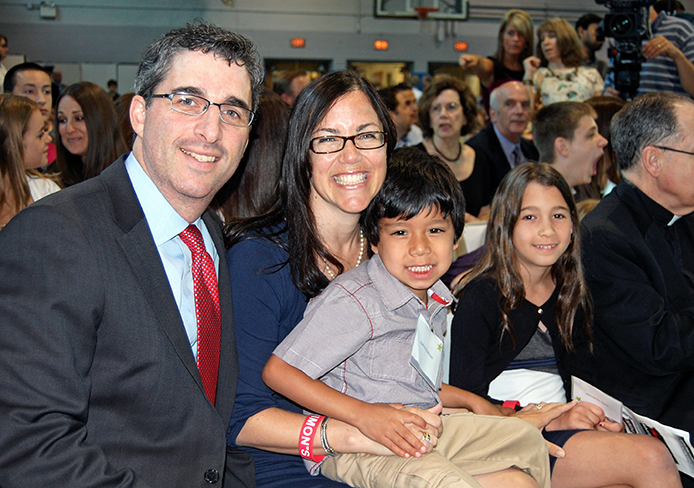
Darren (left), Phyllis, Jaden and Sally Sudman pose for a photo at the signing of the Pennsylvania Sudden Cardiac Arrest Prevention Act May 30, 2012.
Credit: Courtesy of Darren Sudman
Darren and Phyllis Sudman put their son Simon down for a nap Jan. 24, 2005, just more than 90 days after he was born.
Simon never woke up.
Since then, his parents have been working on the organization they co-founded, Simon’s Fund, in efforts to ensure other families don’t have to deal with losing their child to similar, preventable causes.
Simon died because of an undetected heart condition called Long QT syndrome, despite being born a “healthy baby,” according to his mother.
“There were no problems,” said Phyllis Sudman, a 1993 graduate of Ohio State, adding that Simon’s physical test scores were normal. “And then … we put him down for a nap, and he didn’t wake up.”
Phyllis Sudman said the coroner and Simon’s pediatrician both encouraged her and her husband to get their hearts checked. When they did, Phyllis Sudman was also diagnosed with Long QT syndrome, the heart condition which had killed her son.
Long QT syndrome increases one’s likelihood of having an irregular heartbeat, which can lead to fainting, palpitations or sudden death. About 10 percent of babies with Sudden Infant Death Syndrome had mutations or genetic defects for Long QT Syndrome, according to the Mayo Clinic.
“Then we started hearing about these students who would drop dead, particularly student-athletes,” said Darren Sudman, a 1992 OSU graduate who has been working on pushing legislation related to sudden cardiac arrest as well. “And so we decided that we wanted to try to prevent other families from having to go through what we went through.”
Simon’s Fund is an organization which provides free heart screenings to children, mostly in the greater Philadelphia area where the Sudmans live.
“(We) provide free heart screenings to students so that we could find these conditions before they killed students, because almost all the conditions that lead to sudden cardiac arrest or death of kids are detectable and preventable with an EKG (Electrocardiogram) test,” Darren Sudman said.
In the about seven years since the Sudmans founded Simon’s Fund, thousands of children have been scanned.
“We’ve screened over 6,000 kids and found over 50 that have heart conditions. And so that’s one out of almost every 100 kids,” Darren Sudman said.
In an effort to create a standard of care that would require all children to get their hearts checked, Darren Sudman helped craft a bill, which was signed into law in Pennsylvania. The bill was introduced June 16, 2011, signed into law by Pennsylvania Gov. Tom Corbett on May 30, 2012 and was implemented two months later.
The Sudden Cardiac Arrest Prevention Act “requires parents of student-athletes to review and sign an information sheet about sudden cardiac arrest before each season begins” and “requires coaches and athletic directors to complete an annual online training course on sudden cardiac arrest,” according to a statement from Darren Sudman and Pennsylvania Rep. Mike Vereb, who introduced the bill.
On Aug. 12, Illinois Gov. Pat Quinn signed the bill into law in his state, becoming the second state to pass such a law.
The bill was introduced in Ohio May 28 by Rep. Connie Pillich, under the title HB180. Pillich said sudden cardiac arrest legislation is necessary for the health and well-being of young people.
“Playing sports should be fun, and should build both strength and character in children,” Pillich said in an email. “But participating in athletics should not risk a child’s long term mental or physical health. Because we are learning much more about the dangers of concussions in young athletes, this measure is both appropriate and needed.”
The bill remains pending in six states, including Ohio.
Dr. Peter Mohler, the director of the Dorothy M. Davis Heart & Lung Research Institute at the Wexner Medical Center, leads research at OSU on “being able to understand these arrhythmias before they happen,” he said.
“Very often, in whether it’s a child or an adult, usually the first, or very often, the first symptom is the sudden event,” Mohler said. “And so, unlike a lot of disease where you get a little bit of a lead time before you start developing symptoms, (with) these electrical-based cardiac events, again, very often the first manifestation of them is the cardiac arrhythmia, and very often (it’s) syncope, which is the same thing as fainting, or death.”
He said the methods his team uses to try to be able to identify children who might be affected by an arrhythmia later in life include cardiac imaging (heart screenings), looking at genetics and looking at family history.
Mohler said the goal is to be able to find children who might be at risk and “intervene early,” because many times the arrhythmia is preventable if treated early. He said interventions to prevent a cardiac arrhythmia include a drug called a beta blocker that “slows how active your heart is” or a pacemaker, or an implantable defibrillator.
Beyond that, Mohler said education can be helpful.
“There’s some very simple things that we can do in the community to kind of push recovery, which is education for athletic trainers, and parents, and people in the schools to know very simple things like CPR,” Mohler said. “And then the other thing is the use of AEDs (automated external defibrillators), and having AEDs available.”
AEDs stop the arrhythmia to allow a person’s heart to return to a normal rhythm.
As the Sudmans push for changes in legislation, education might become more widespread.
Phyllis Sudman said she thinks of Simon’s Fund as a way to continue the legacy of her son.
“There’s nothing more meaningful when you talk to a family whose kid requires some sort of follow-up care or surgery or procedure and they’re just thankful,” Phyllis Sudman said. “There’s no words. And because of Simon, these kids’ lives are saved.
“I think our 3-month-old son has had more of a huge impact on kids’ lives than most people do in their lifetime.”


